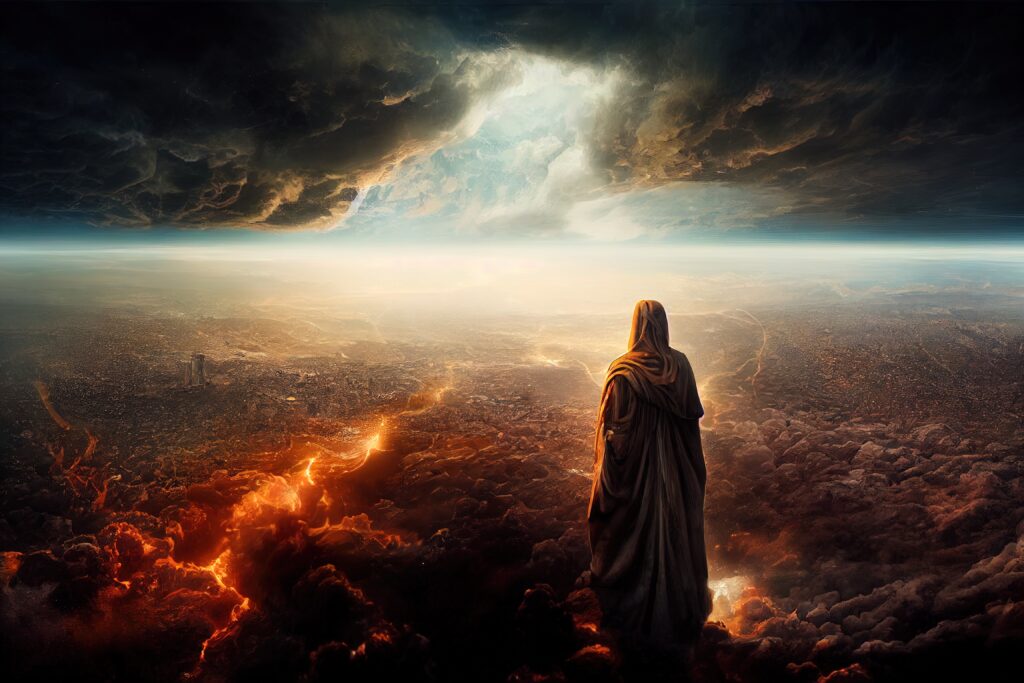
Between Heaven and Earth.
We looked at Christ’s seven messages to His people on earth. Now John’s vision shifts from earth to heaven and focuses on the “things which must take place after this” (Rev. 4:1)— the future. The vision of chapters 4 and 5 takes place in heaven’s throne room. The scene of chapters 4 and 5 symbolically portrays God’s control of history and of the plan of salvation. Before the future is revealed, however, we are shown the centrality of Christ’s high-priestly ministry in heaven, through to His sovereignty over the affairs of the earth and to His redemption of the human race. In such a way, chapters 4 and 5 provide Heaven’s perspective on the meaning of future events recorded in the rest of the book. Remember the title of the book – it is the Revelation of Jesus Christ.
One also may notice that while the messages to the seven churches were written in somewhat straightforward language, from now on the book employs even more symbolic language that is not always easy to interpret. This language is taken from the history of God’s people, as recorded in the Old Testament. A correct interpretation of Revelation requires a proper understanding of its symbolic language in the light of the Old Testament. Especially the major stories and the Hebrew sanctuary service. The Hebrew sanctuary was a symbolic portrayal of the entire plan of salvation. The centre piece of the whole system was “the Lamb.” The Lamb represented the Divine substitute that now becomes the centre of universal worship. Take off your metaphorical shoes because you are about to tread holy ground!
Starting in Revelation 4:1, Jesus invites John to come up to heaven to be shown a panoramic survey of history from his time until Christ’s return. The language of Ezekial 1:26-28 is employed here because the visions are similar.
The apostle looked through the open door into the heavenly temple and at the throne of God. The throne symbolizes God’s rule and governing authority over creation, while the rainbow around the throne signifies God’s faithfulness to His promises (Gen. 9:13–16; Isa. 54:9, 10). However, Satan, who usurped the dominion of this earth and is God’s adversary, has disputed divine authority. He has even stolen the rainbow image. The central issue in the great controversy between God and Satan is about who has the right to rule. The purpose of the heavenly council that John saw gathered in the heavenly throne room was to affirm God’s rightful rule over the universe (Rev. 4:1–8, Rev. 5:11–14).
Then as I looked, I saw a door standing open in heaven, and the same voice I had heard before spoke to me like a trumpet blast. The voice said, “Come up here, and I will show you what must happen after this.” – Revelation 4:1.NLT
The scene of Revelation 4 and 5 is one of the most dramatic in the Bible. I am astonished by it! Apparently, scholars say it is even more glorious in the original language than it is in translation. Read it and receive an unbelievable thrill as you envision what worship in heaven must be like. The scene starts slowly but then crescendos and crescendos until the entire universe becomes a single vast, antiphonal choir ringing out the praises of the Lamb and the One sitting on the throne (Rev 5:11-14). The scene then concludes as the four living creatures utter “Amen” followed by thunderous silence.
A danger readers face when going through a passage like Revelation 4 and 5 is the tendency to make too much of every detail and thereby miss its primary purpose. That purpose is to set forth the greatness of the heavenly throne room, the greatness of God and, therefore, the surpassing greatness of the Lamb that was slain. The throne room of God lays all earthly claims to power and glory in the dust. When one has had a glimpse of the open gates of heaven, it makes no sense any more to be afraid of earthly powers or even specific human beings. The passage invites us to place all sources of earthly intimidation in the shadows of God’s transcending power and glory, and to acknowledge Him as the one true object of worship. When we truly know Him, we will know what true worship is all about.
Jesus said He was the door (John 10:7-9) . One of His many “I am” claims in the gospel of John, where His divinity is affirmed. Whenever Jesus was challenged on His identity He used the title that God – Yahweh – used of Himself in the Old Testament. This occurred 7 times on John’s Gospel and was the reason why the Jewish leaders wanted to stone Him and then crucify Him.
Using language that was reminiscent of Daniel’s words to King Nebuchadnezzar when he interpreted his dream, John was told what “must take place after this.” (4:1) After what? The message of the seven churches had given us a panorama, from the earthly view point, of the churches spiritual journey, as well as that of the individual who can embody characteristics of those 7 churches.
In comparing the similarity of both Ezekiel and John we see that both writers were overwhelmed with what must have been like trying to gaze at the noonday sun. The Good news is, that both see that God is on His throne! Remember this is symbolic conceptual language to aid our understanding of what is going on – God is in control! The rainbow around the throne reminds us of the promise God made after the flood. As we proceed through these two sublime passages we will be lead to stand in awe at Divine providence and Their plan of salvation.
There is only one possible response considering the heavenly throne room: repent, bow down and acknowledge the only One who is truly worthy of my worship.
